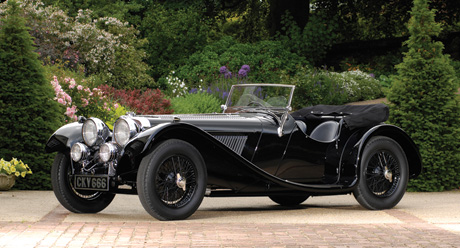Chassis Number: 39002
The new cars were assembled from parts from many suppliers, and they might have looked more hand-finished than this piece of perfection.
This absolutely stunning SS100 stands today as what must be the finest example anywhere in the world. The quality and detail of its restoration rivals the finest ever performed on any motorcar. With the aim of presenting the car at the Pebble Beach Concours d’Elegance, the ultimate goal of the restoration was to set a new standard of detail and finish when restoring the highly original, matching-numbers example. The work was undertaken by respected marque authority JD Classics, located outside London. Handsomely presented in its original black livery with navy blue leather, the car still retains its original U.K. registration number CKV 666.
The car was originally ordered by Captain John P. Black, the managing director of the Standard Motor Company, Ltd., a company that manufactured the engine and other major components for SS Cars Ltd. Captain Black specified the black paint and the non-standard blue leather interior which was an extra-cost option. For reasons unknown, the Captain never took delivery of the SS100 and it was subsequently sold to a Mr. Bellhouse of New York, who is considered to be the first owner. Research has uncovered a few additional owners from the car’s early history: T Hecht and G Daigh, both from Georgia, then reportedly SS Roberts. Later the car came to be in the collection of Don Williams of Blackhawk. In 1988, it was acquired by the Rosso Bianco Collection in Germany before finally coming to the present owner in 2006.
The exceptional restoration, which included documenting correct parts and components down to the smallest detail, was performed with months of collective research. As an example of the efforts that were taken, the wiring loom, while barely visible, was carefully researched for correctness and it was discovered that the original wire used in these cars had a chevron pattern in the braid for the trace color. This wire has not been produced for decades, so rather than use concours-acceptable cloth-insulated wire, 20 meters of each color combination necessary to complete the wiring loom was custom braided and made into the wiring harness. Most of this wire is under wrapping or is housed within conduit, but on close inspection, it presents just as when the car left the factory.
The windshield wiper motor is extremely rare and is correct for the car. The armature was rewound and the intricate linkage needed to make the wipers function from a pivot point at the bottom of the windshield, as is proper, had to be made and painstakingly adjusted to work without fault.
The black paint on this superb automobile borders on perfection. The scores of louvers in the bonnet have been perfectly prepared, painted, sanded and polished, representing the truly stunning standard of restoration and hundreds of hours spent on the bonnet alone. It is, without a doubt, one of the greatest restoration efforts ever lavished on an automobile.

